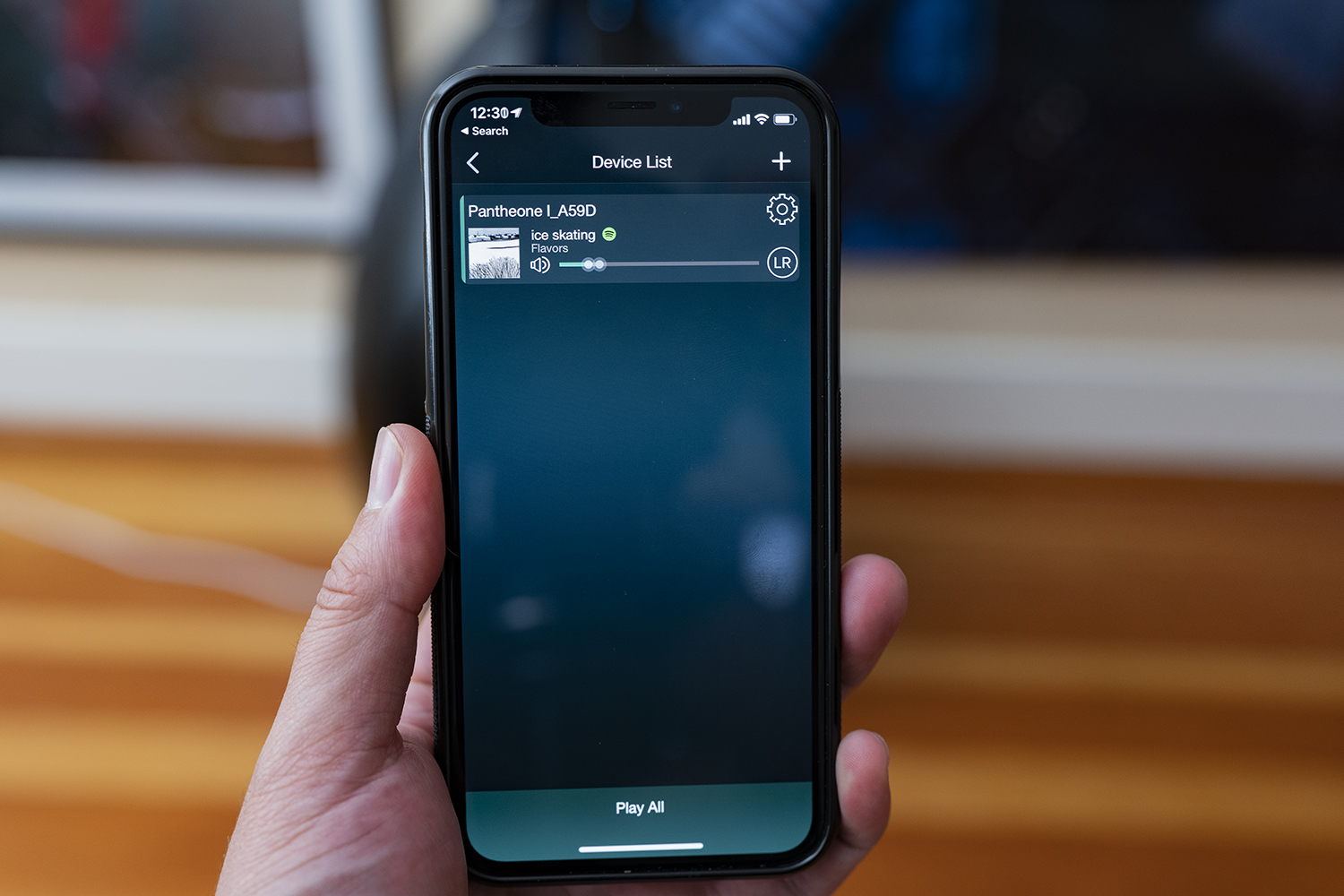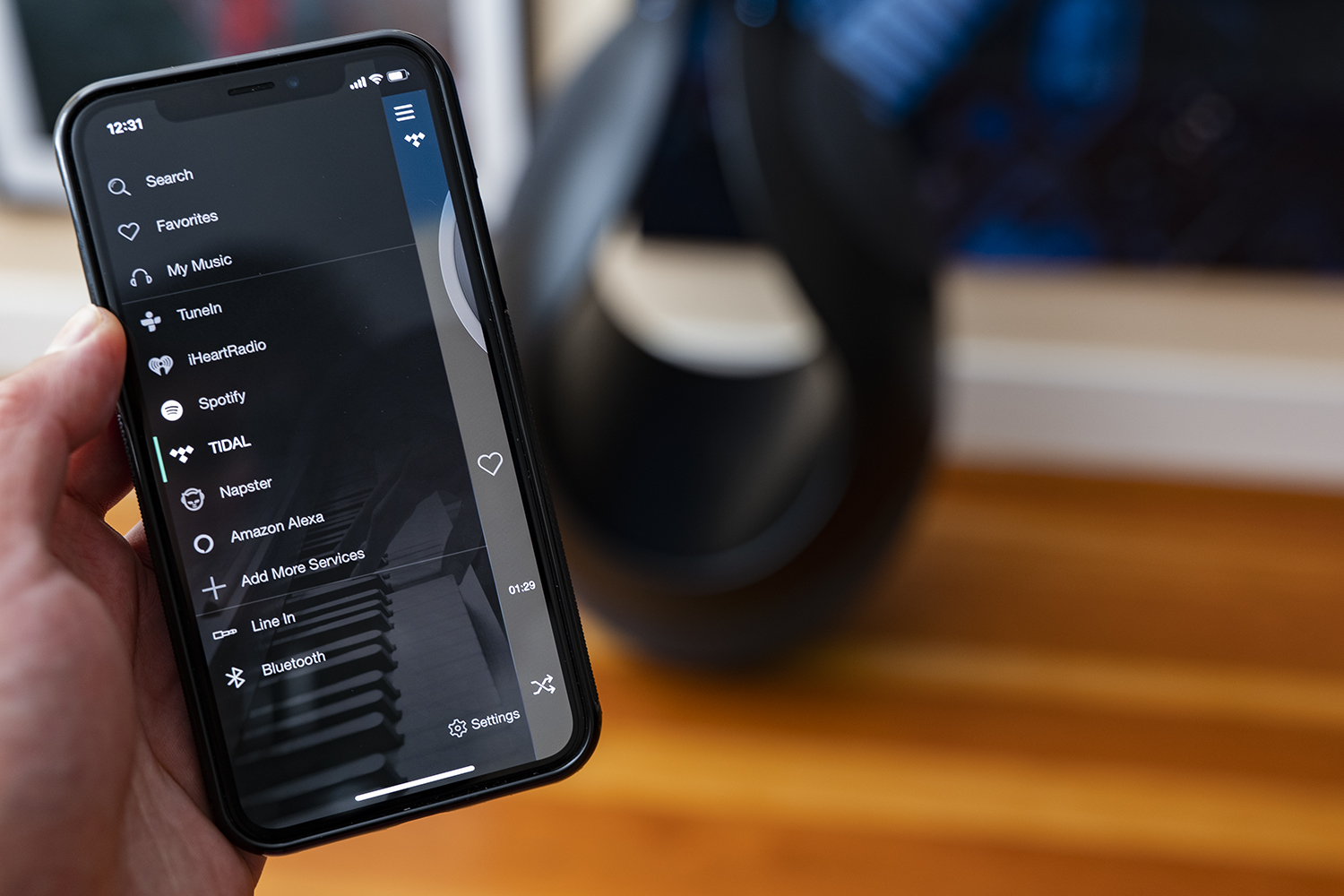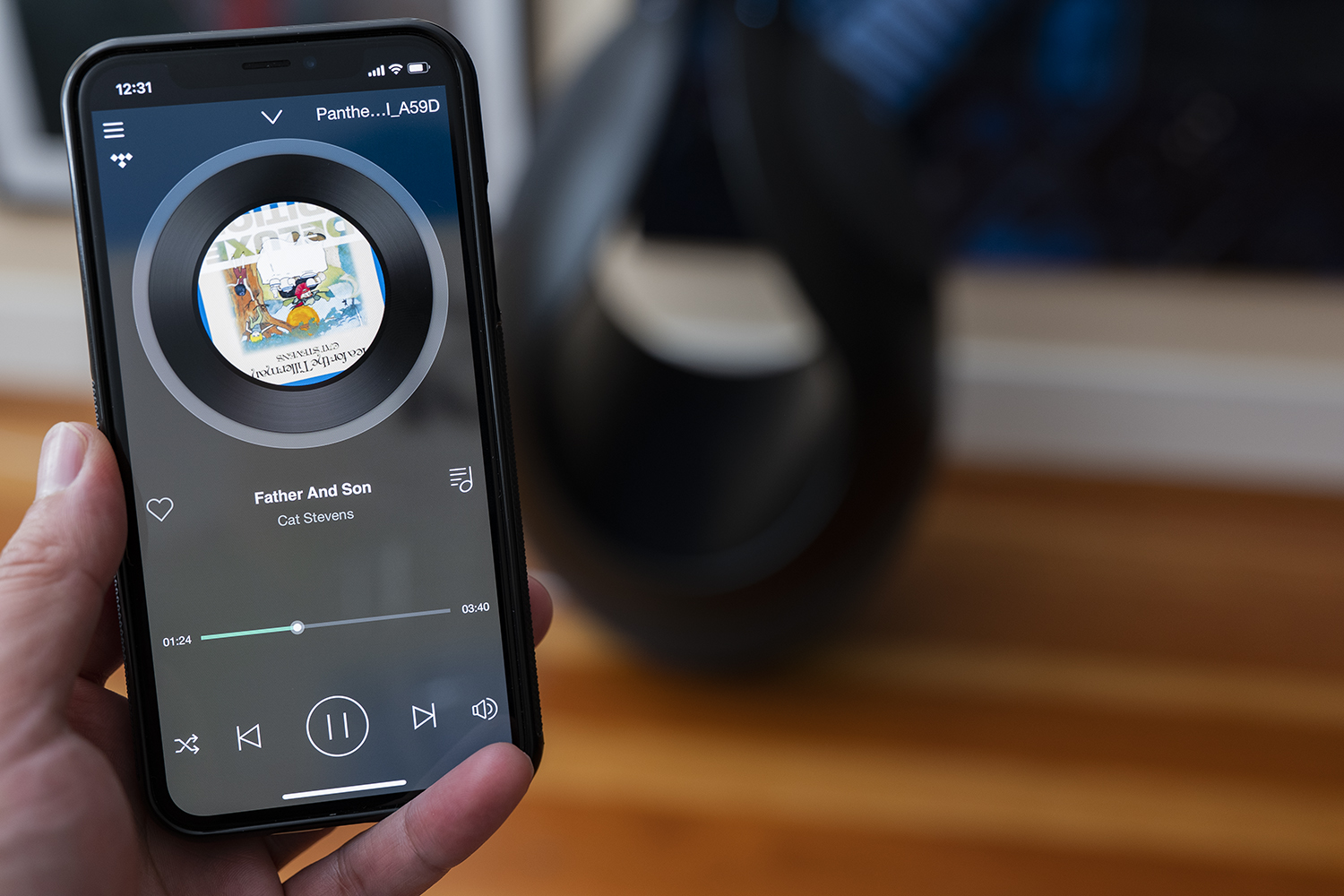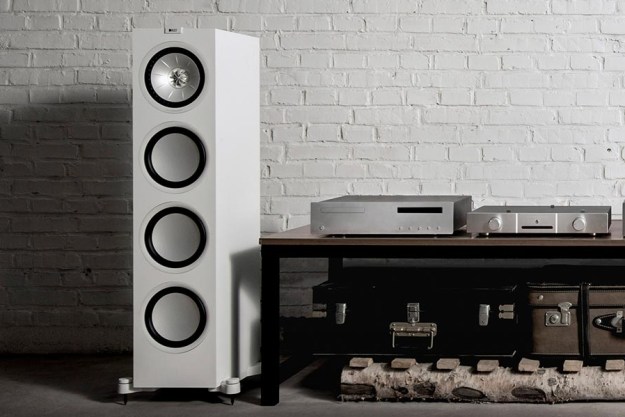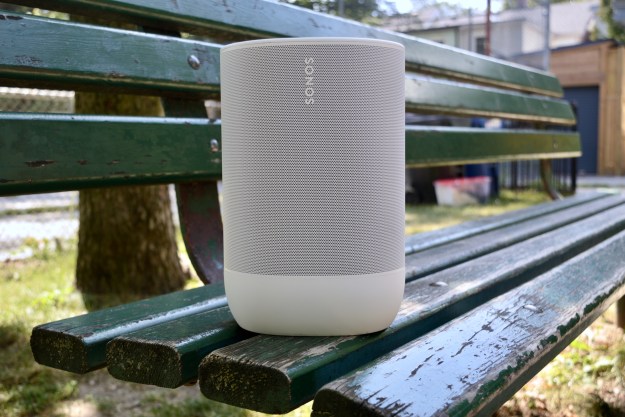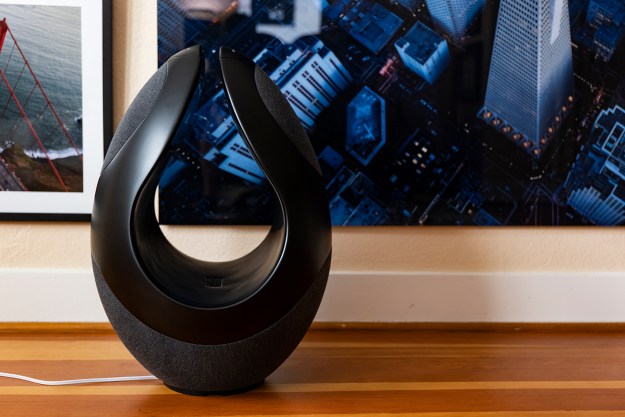
- Outstanding audio quality
- Connected: Bluetooth, Ethernet, Wi-Fi, 3.5mm, and AirPlay
- Unique design
- Supports high-resolution audio
- Easy to use and set up
- Expensive
- Imperfect app experience
When I interviewed the founder of Pantheone about his upcoming connected home speaker system, I saw a passion in him for creating something many have attempted and few have achieved: A home audio system designed to look as good as it sounded. I have to side with him — most speaker systems are inherently ugly because they’re not designed to be anything other than utilitarian. Most of the time, we just want to hide them (which is a major factor we consider when reviewing soundbars, for example).
The Pantheone I is not a speaker anyone will try to hide. But does it sound like $2,750, and does it have the brains we expect in 2020? Let’s go through it.
Unboxing the behemoth
I feel bad for the delivery driver that hoisted the 60-pound Pantheone box up a flight of stairs to my front door.
It was just as hulking as I expected. The speaker itself was safely cradled in foam inside a box, inside another box, wrapped in plastic and held together with shipping straps and thick cardboard bumpers. I was kind of appalled at how much packaging was strewn across my living room. It’s a lot. Pantheone isn’t going to score any points here with regards to sustainability, but I will say the product made it all the way to me without a blemish.

The first thing you see when you open the interior box is a small zip-top bag that contains two white gloves for what I assume is “white glove service.” I found the inclusion of those gloves cute and on-brand, but also rather silly and hilarious as I have never experienced white glove service that I actually had to partake in myself. Silly as they are, I appreciated them, as the Pantheone unit can attract fingerprints and the included gloves were definitely helpful in mitigating that while I moved it to its final location.
Aside from being ensconced in foam, the Pantheone ships in a silk-like bag that, while it looks nice, feels a bit gratuitous. It’s not like I’m planning to bag this speaker up and take it with me anywhere.
The Pantheone is powered by a standard power cable, but it’s oddly short for a home speaker. Unless you have outlets in your floor, four feet of cord will not be enough for most people to get the unit into a, central location in the living room. Us plebeians with only a few wall outlets per room are most likely going to need an extension cord. My black speaker also shipped with a white cord, which stands out a heck of a lot more than black would on my wooden floors. I wish Pantheone included both colors in the box to give me more flexibility.
On the bottom of the unit, you will find the power port as well as the physical on/off switch. Since there is a touch-sensitive power button on the top of the unit as well, I’m not entirely sure why it needs that physical switch at all. It might have something to do with the power converter I’m sure is packed in here (since the cable doesn’t have a transformer), but that’s just me guessing.
Physical controls
The Pantheone I is a smart speaker like a Sonos or Amazon Echo, and thus needs you to take a few minutes of setup in order to start using it. Also like
Setup is gratefully fast and painless.
You get basic music controls on the top like volume, play/pause, and skip, but since there is no screen, you must rely on a second device to send the speaker content (the same way

Since the buttons don’t physically click, they play a chime every time you press one to acknowledge your command. This can get annoying for adjusting the volume since it interrupts the sound of your music. Nitpicky, I know.
Easy on the eyes
A section of a review dedicated to how a product looks is pretty uncommon for us but remember: This isn’t just a speaker, it’s art.

I’ve shown the Pantheone to a number of friends and colleagues, and I’ve gotten a pretty polarizing set of responses to its design. One of my fellow editors called it hideous and refused to spend more than a couple seconds looking at it. My wife likes it and thinks that if our house wasn’t designed in a French Country style but instead a modern or contemporary one, it would look fantastic. One of my staff writers said it looked like the eggs from Alien. Another said it looked “majestic.”
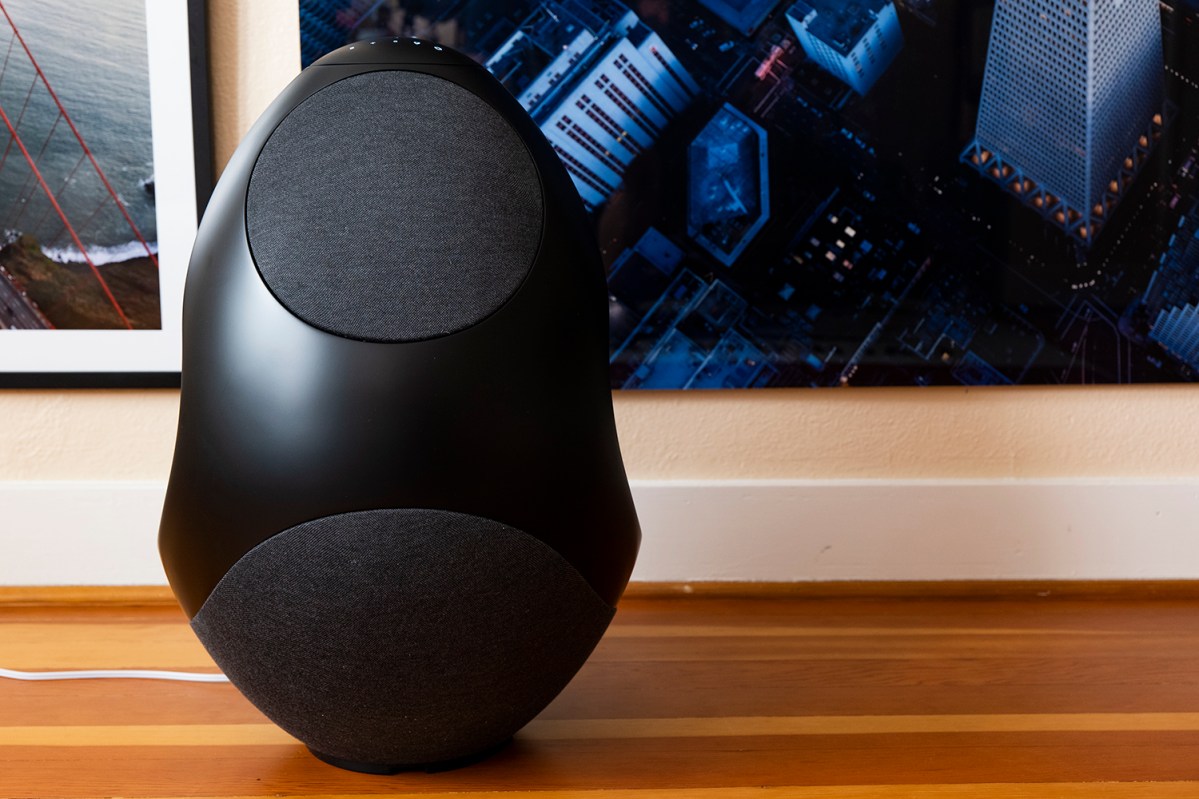
I think they’re all correct. Art is supposed to be subjective, and what appeals to me won’t necessarily appeal to you. What I think we can agree on is that the Pantheone looks highly unusual for a speaker, and if you like the lines it draws and can see it in your home, that’s all that matters.
App and integration
With Spotify labels plastered all over the Pantheone box and manuals, it’s clearly the streaming platform of choice for this speaker. Fortunately, the Spotify experience is fabulous as well, matching the experience you would expect with
Though several other services are supported, their integration isn’t necessarily quite as good. TuneIn, iHeartRadio, Apple Music, Tidal, and Napster are all supported directly, but I found that the Tidal experience was not as streamlined. Unlike with
Granted,
Through the Pantheone app, you get access to all a music streaming service’s offerings, so if you don’t mind using Pantheone’s interface, you won’t have a problem here. I have noticed, however, if you let your phone go to sleep, the Pantheone app seems to forget it’s connected and has to spend a few seconds reconnecting each time. Music continues to play without interruption, but it’s not a perfect user experience. Additionally, you can’t control the volume on the Pantheone I from your phone unless the app is open (such as from the lock screen, as you can when using the Spotify app).
The Pantheone I works with AirPlay, but it suffers from more than a second of delay whenever you select a new song, pause a track, or even adjust the volume from your phone. This feels like something that can be ironed out with a firmware update, and I hope they do it because it is annoying enough that I stopped using AirPlay with the Pantheone altogether.
Software tends to be the tallest hurdle for companies who even make great hardware to successfully jump, so I’ll cut Pantheone some slack here, especially since this is the company’s first product.
Alexa integration works flawlessly. When you speak to it, the illuminated top control buttons turn a dark blue to indicate your voice has been heard, and flicker when initiating on a command. It’s sufficiently visible and better integrated than I’ve seen in most other Alexa-enabled devices.
There is currently no way to adjust the Pantheone’s EQ values to your personal preference (other than with Spotify on mobile when connected directly via 3.5mm jack), but this functionality will be coming to the app at a later date.
Room-filling sound
Look, if a giant $2,750 speaker didn’t sound great, we would have a problem. Luckily, there is no problem here — the Pantheone produces exceptional sound. It’s multi-level driver layout and two-sided design results in some truly wonderful audio projection that carries across and through rooms with incredible fidelity. While other speakers I’ve tested require more than one unit to get a strong sense of immersive sound, the Pantheone achieves it from a single monolithic egg.
For a company’s first product, the Pantheone is shockingly, outrageously good.
I personally love the sound quality of professional studio monitors as opposed to the processed sound that you can get out of more consumer-focused headphones. It tends to be more neutral in quality and clean, with even emphasis across all the entire frequency spectrum. In that same sense, the Pantheone is like a pair of fabulous over-ear studio

The highs are wonderfully balanced with the mids, and the bass is strong but not overwhelming. High-resolution audio streams from Tidal highlight the effect. For example, in some songs where the bass is clearly more important, you’ll hear it get a boost. In others, if it will fall back so as not to overwhelm the other channels. If you ever wondered how a musician wanted their music to be heard and you trust Tidal is getting all that information in its Master tracks, then know the Pantheone is being true to that sound.
Look, if a giant $2,750 speaker didn’t sound great, we would have a problem. Luckily, there is no problem here.
Most impressively, the Pantheone manages balanced EQ regardless of its volume level. From quiet background music to window-shaking maximum power, I never felt like what I was hearing was not exactly perfect to how the music was supposed to sound. This level of control is unusual and exceptional.

There are basically no other speakers like the Pantheone I, but if we had to compare we would immediately look at
I took a Sonos Move and put it next to the Pantheone just to hear the difference in sound quality. I did the same with a Bluesound soundbar that I praised for its musical chops. Totally unfair, I know, but I was curious since the Move is seen as a great speaker and I liked the Bluesound bar.
Side by side, the Pantheone blows both out of the water — as it should. Where there is a murkier, cloudier blend where the treble, midrange, and bass intersect on the
Our take
The Pantheone is wildly expensive, and that is its greatest flaw. It pains me that the vast majority of those who read this review will never personally experience the audio quality from this speaker because they’ll never see or hear one in person. It’s not only a beautifully designed speaker aesthetically, but also from both an integrated and auditory perspective. For a company’s first product, the Pantheone is shockingly, outrageously good. Here’s to hoping the company can make additional products that are more approachable to the average person because it clearly has the chops to compete with the goliath that is
Is there a better alternative?
As I mentioned, there really isn’t any other product quite like the Pantheone I. You can find expensive, high-fidelity connected speakers like the Devialet Phantom that we’ve looked at in the past, which might be the closest thing to a direct competitor (though I have not personally tested one). Or you can get a
How long will it last?
The Pantheone I is built incredibly well, and not out of traditional plastic, but resin. Bolstered by regular firmware updates and a great 2-year warranty, I expect the Pantheone I to work wonderfully for years to come.
Should you buy it?
If you can afford to drop $2,750 on a home speaker solution and your décor fits with the Pantheone’s unique styling, then I would strongly say yes. The Pantheone I is extremely expensive, but I am confident you’ll be able to enjoy it both when it’s playing music and when it isn’t.
Editors' Recommendations
- The Sonos app gets a major overhaul as the company prepares for next-gen products
- We’ve tried them all — these are the best Sonos speakers in 2024
- Best Sonos deals: Save $360 on speakers, soundbars and more
- Best Bluetooth speaker deals: Save on Bose, Sonos, JBL, and more
- Q Acoustics’ new 5050 floorstanding speakers are built to fill big rooms with sound


